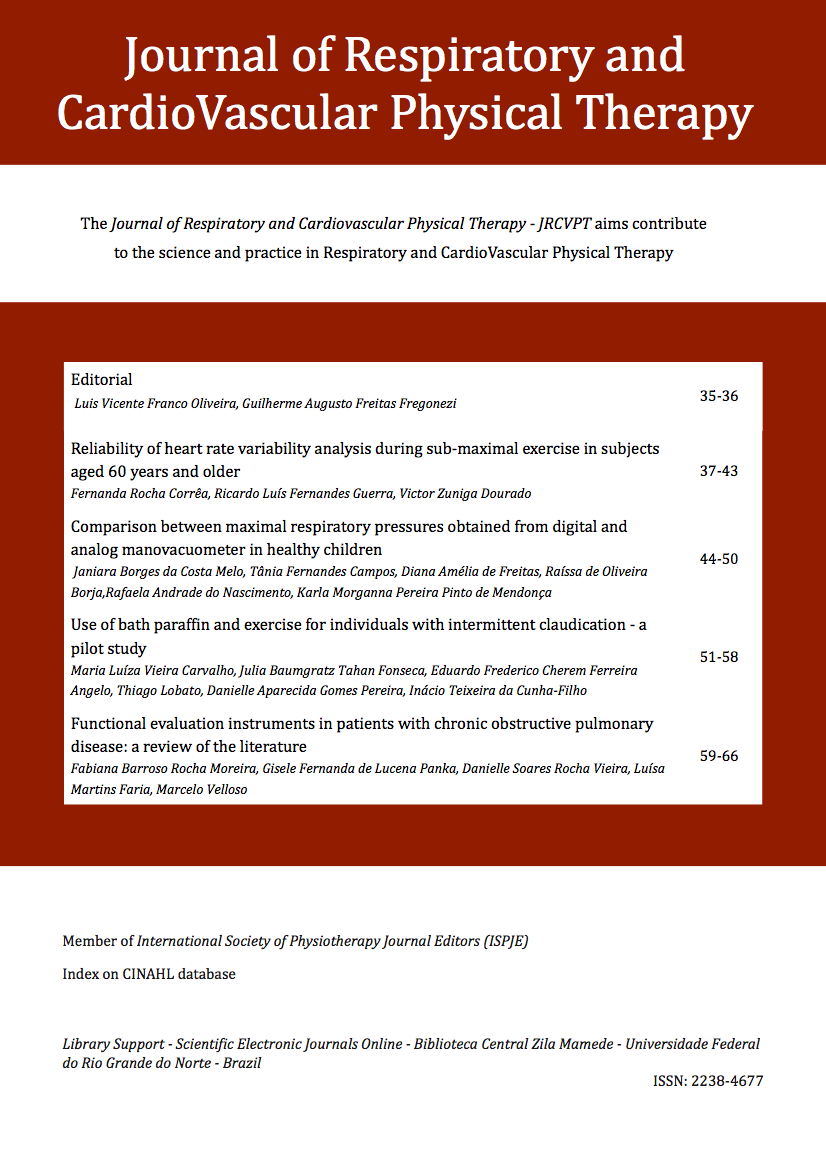Comparison between maximal respiratory pressures obtained from digital and analog manovacuometer in healthy children
Palabras clave:
Respiratory muscles, Muscle strength, Evaluation, Diagnostic equipment, Child.Resumen
Background: The assessment of respiratory muscle strength in children is needed for clinical reasons; the instrument used to measure the strength of respiratory muscles is the manometer, which can be either analog or digital.
Objectives: To compare the values obtained by analog and digital manometer in healthy children aged between 7 to 11 years old.Methods: 49 schoolchildren (25 boys) from public schools were assessed. Anthropometric measurements were collected in addition to the measurement of maximal respiratory pressures by analog and digital manometer. The paired Student’s t test was used to compare the measurements of maximal inspiratory and expiratory pressures obtained by the two instruments. The Bland-Altman analysis assessed mean differences (BIAS) and agreement between the equipment’s used.
Results: No significant difference between values for maximal respiratory pressures in both devices. However, Bland-Altman analysis showed large limits of agreement between the values obtained by the two manometers.
Conclusion: Data from this study demonstrate that, although no significant differences were observed between the measures obtained by the two devices in a sample of healthy children, agreement between them showed a clinically unacceptable range for measures of maximal respiratory pressure.
Descargas
Descargas
Publicado
Cómo citar
Número
Sección
Licencia
Copyright Transfer Statement
The author(s) of the article, as specified here, hereby transfer(s) to the Revista de Fisioterapia Respirtória e CardioVascular (Journal of Respiratory and CardioVascular Physical Therapy) all copyright ownership rights, title and interests that the author(s) may have or may come to have in and to the article and any revision or version thereof, including, but not limited to, exclusive right to print, publish and sell the article anywhere in the world, in any language and in any media.
This agreement will be considered effective and valid if and when the article is accepted for publication.
If the article contains any copyright-protected material from a third party, the author(s) must obtain written permission to reproduce the said material in the article from the copyright holder and send it to the Revista de Fisioterapia Respirtória e CardioVascular (Journal of Respiratory and CardioVascular Physical Therapy).
The author(s) guarantee(s) the holding of proprietary rights to the article; not having granted or transferred any rights to the article to any other persons or entity; that the article is susceptible to the demand for rights by its author(s); not having infringed upon any author rights, trademark or patent; not having violated the right to privacy or publicity of any person or entity; that the article does not contain any defaming subject; that the factual statements made are true or are based on reasonably accurate research; and, finally, that, the author(s) has/have no reason to believe that any of the formulas, procedures or prescriptions contained in the article will cause damage if used or followed in accordance with the instructions and warnings contained in the article.
The author(s) will indemnify the Revista de Fisioterapia Respirtória e CardioVascular (Journal of Respiratory and CardioVascular Physical Therapy) against any costs, expenses, damages or liability that the Revista de Fisioterapia Respirtória e CardioVascular (Journal of Respiratory and CardioVascular Physical Therapy) may incur as a result of accidental omissions of these guarantees. These representations and guarantees may be extended to a third party by the Revista de Fisioterapia Respirtória e CardioVascular (Journal of Respiratory and CardioVascular Physical Therapy).
Date:
Note: Each author must individually complete and sign this form
1) Author:
Signature: _________________________________
2) Author:
Signature: _________________________________
3) Author:
Signature: _________________________________
4) Author:
Signature: _________________________________
5) Author:
Signature: _________________________________
6) Author:
Signature: _________________________________
7) Author:
Signature: _________________________________
8) Author:
Signature: _________________________________




 English
English Español (España)
Español (España) Português (Brasil)
Português (Brasil) Français (Canada)
Français (Canada)